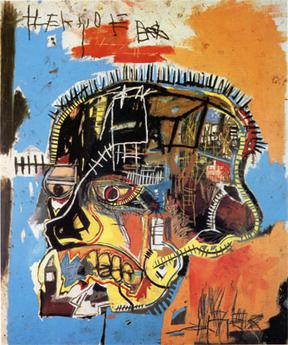"I don't listen to what art critics say. I don't know anybody who needs a critic to find out what art is." Untitled acrylic and mixed media on canvas
Untitled acrylic and mixed media on canvas
by Jean-Michel Basquiat, 1984
Read a review of the recent Basquiat Exhibit at the Brooklyn Museum in the Brooklyn Rail.
The Wikipedia page...click here.
AND
BANKSY's hompage.
explore
|
|
|
\/
http://www.banksy.co.uk/
scroll through these at your leisure ------------------>INDOOR WORKS
Tuesday, August 7, 2007
Jean-Michel Basquiat and BANKSY, as promised
Posted by
eric
at
10:21 PM
0
comments
![]()
thinking about the Gates

(while looking for a good picture of the gates i found this. graffiti to question the art... a different twist, eh?)
Below is the link to the Christo and Jeanne-Claude's website. Click on the SOME ARTWORKS button and browse through their work a bit. They have wrapped entire buildings and bridges, and surrounded islands in the Florida keys. Why? I have no idea. But I think it's awesome. Read about their process - fascinating stuff. http://www.christojeanneclaude.net/index.shtml
I pulled this Q&A directly out of the FAQs on their site:
Why are their works so big. What's the point?
Christo and Jeanne-Claude's works are entire environments, whether they are urban or rural. The artists temporarily use one part of the environment. In doing so, we see and perceive the whole environment with new eyes and a new consciousness.
The effect is astounding. To be in the presence of one of these artworks is to have your reality rocked. You see things you have never seen before. You also get to see the fabric manifest things that cannot usually be seen, like the wind blowing, or the sun reflecting in ways it had not before.
The effect lasts longer than the actual work of art. Years after every physical trace has been removed and the materials recycled, original visitors can still see and feel them in their minds when they return to the sites of the artworks.
There is no other way to describe that the feeling of that effect other than to say it is magical.
Posted by
eric
at
10:02 PM
0
comments
![]()
the Serra installation video - in fast forward!
i like the beginning of this video. they put the first piece down, then decide... 'No, a little to the left.' Then, 'hmmmm. No, move it back to the right.' It's like hanging a picture frame that weighs 30 tons. Turn up the volume and consider how MoMA is presenting this work... (And don't you just love time-lapse photography...)
i've watched a few of the videos that appear at the bottom of the You Tube screen when this one ends. they're worth it to get an idea of how long it took to design and build those (some more than 3 years). there's a moment in one where he asks an engineer if it's possible to build the shape he wants to build and the guy says he doesn't know. it was never attempted.
Posted by
eric
at
10:27 AM
0
comments
![]()
Monday, August 6, 2007
This will not be eloquent.
I enjoyed our time at the MoMA. "Automatic Update" was great; I enjoyed the interactiveness of those two works of art (the one that spits out questions and the one that creates a dialogue in pictures). And because our generation is inundated with so much media (convergence!), it's interesting to see how artists approach the rapid changes in technology. Who knows, maybe in a year or so, someone will write a book in "txt message" language.
Onto Richard Serra. The giant sculpture exhibit...what can I say? It took about 10 minutes to circle the entire thing on the 2nd floor. I did not feel enlightened. But it was really cool—I mean, imagine the process of installing those steel contraptions into the MoMA! And the way the metal thingamajigs have been manipulated, placed as if they were ribbons. I stood in the entrance of one such "loop" in the ribbon, trying to imagine if, after a hard day's work, Serra could lie down and look up at the enclosing metal around him. It's claustrophobic. It's a wasteland.
Erik Friedlander's The Broken Arm show, outdoors, was quite interesting. Entirely strings. I wish I could have stayed longer.
That's all.
--Ivana
P.S. Did you know that "thirty" also means "conclusion"?
Posted by
Ivana Ng
at
10:48 PM
1 comments
![]()